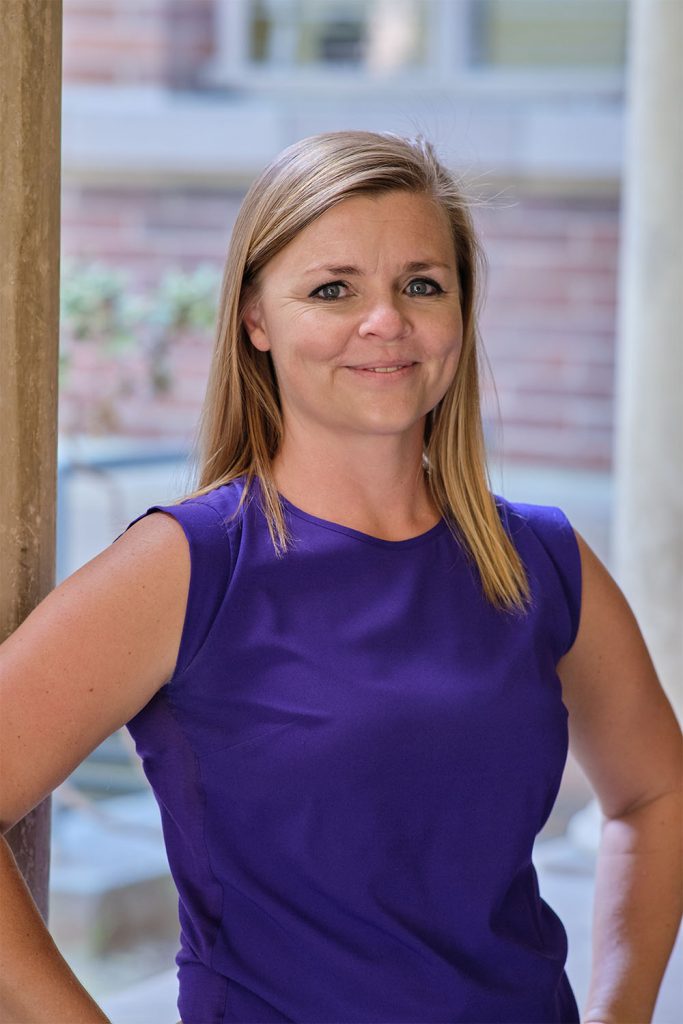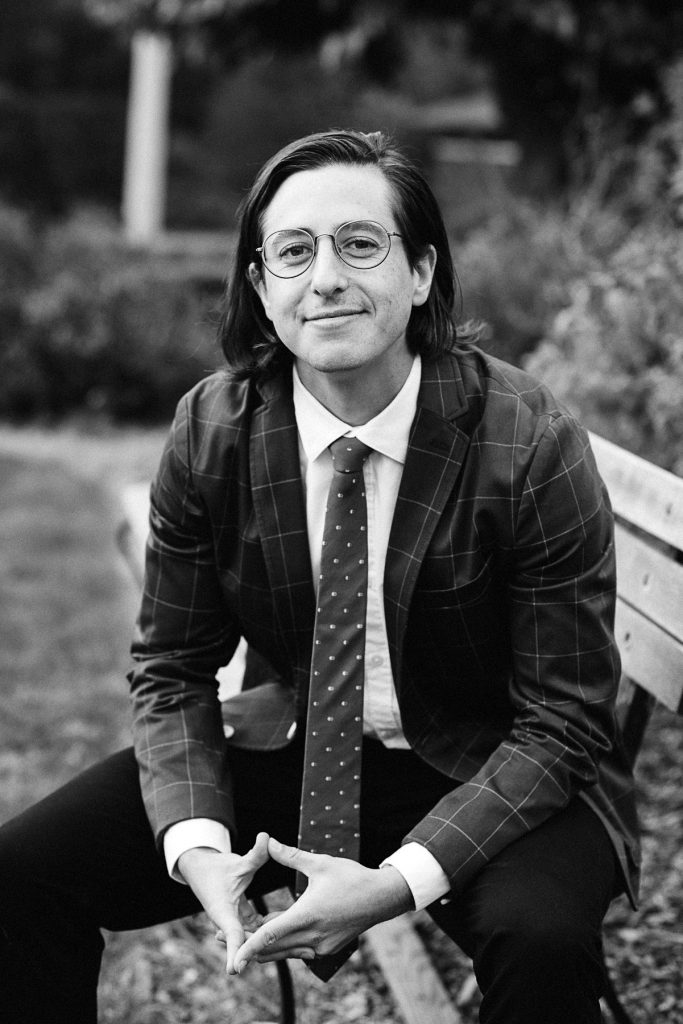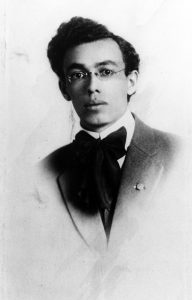

The Leve Center is pleased to announce that two members of our community have been awarded fellowships from the New Directions in Jewish Studies from UC Davis Jewish Studies program: Associate Director Caroline Luce and doctoral candidate Maxwell Greenberg. Congratulations, Caroline and Max! Director Sarah Abrevaya Stein gathered virtually with the honorees to discuss their work, its intersection, and why the Leve Center is such a unique nursery for cutting edge scholarship in the field.
- Can you tell us about the research you’ll be sharing through the New Directions in Jewish Studies fellowship. What questions are you asking? What is at stake in your analysis?
MG: My lecture, “A Palestine on the Pacific: Four decades of Jewish Territorial Dreaming in Baja California,” is the fruits of a project I started in 2017 during my very first Jewish History seminar with you, Sarah! While doing archival research for my seminar paper, I came across one of those classic mid 20th century Jewish pioneer histories that is rich in primary source data and virtually absent on critical analysis. Norton Stern’s book “Jewish Refuge in Baja California,” shed light on a late 19th century plan amongst San Francisco-based, European Jewish immigrants to colonize Baja California for purposes of resettling Russian Jewish refugees. Years of subsequent archival explorations between San Diego, Tijuana and Mexico city revealed to me that the unrealized plan to establish a Jewish colony in Baja California didn’t end at the turn of the century but in fact extended through 1939. The plans for a sovereign Jewish nation-state in Baja California were organized by Jewish American entrepreneurs, philanthropists, religious leaders and were often supported by secular corporate entities who understood the potential colony as a new opportunity for transnational commerce between the US and Mexico. My lecture will examine proposals for the imagined Jewish settler colonies in Baja California from 1891, 1921, 1933 and 1939, alongside Mexican federal responses and regional narratives of community resistance, and I argue that Jewish American strategies of refugee aid through these years mirrored the process of Anglo settler colonization in their aim to create a “frontier” region safe for white Europeans and reliant on Indigenous land theft and displacement. My research contributes to existing scholarship in Jewish Studies that has explored 19th and 20th century Jewish Territorial Nationalism, the movement that paralleled Zionism and pursued possible Jewish nation-states across different regions in the Global South prior to Palestinian occupation and Israeli statehood in 1848. The US-Mexico border region provides a unique geo-political context to this literature, as it clarifies Jewish inclusion into the Anglo settler colonial project in the American West and the modern condition for whiteness in the West. Relatedly, the border region offers a framework linking Protestant Manifest Destiny and Zionism as relational ideologies that have been deployed to transform distinct geographies into collaborative settler projects.
CL: I will be presenting a piece called “California Reds” that examines the experiences of young Jewish communists who were raised in the Yiddish-speaking immigrant milieu in Boyle Heights in the 1920s and 1930s. I too am interested in the legacies of settler colonialism and how they shaped Jewish racialization, both how Jews participated in and benefited from colonial systems of dispossession and dominance, affording them access to inclusion as white settlers, but also how they became “subjects” to the same and the carceral and cultural practices that rendered them subversive racial others. I focus in particular on Boyle Heights, a neighborhood that – owed to the legacies of colonization and segregationist zoning and land use practices – became one just a handful of places in LA where working people who were not considered to be “of the Caucasian race” could live, called home by thousands of Jewish immigrants as well as equally large numbers of Mexican residents and significant Japanese, Turkish/Armenian, Russian, and African American communities. My research asks: how did Eastern European Jewish immigrants engage with and locate themselves within this multiethnic landscape? How did they imagine, debate, and realize their own forms of belonging? While in the book project, I examine the ways that Yiddish-speaking Jews absorbed American colonial mythology and came to think of themselves as white settlers, in this particular project I focus on those who most forcefully challenged it, laying bare the connections between imperialism and racial capitalism in Southern California. While small in number, the young Jewish communists of Boyle Heights came to loom largely in the settler imagination and, as such, were violently attacked by their non-Jewish peers, demonized in the press, repeatedly arrested, incarcerated, and in some cases, deported. As I show, the hysteria surrounding their activism rendered “Russian Jews” a type of racial other associated with deviance, subversion, and un-American behavior and one indelibly linked to Boyle Heights, their racialization marking all Jews who lived there as suspect of subversion. By doing so, the project offers new insights about the connections between race-making and place-making in Los Angeles, and shows that both Jewish inclusion and Jewish otherness in Southern California were intimately bound to the ideological and racial projects of settler colonialism.
- How do these interventions relate to your research subjects and methods? Do you think innovative research might hinge on novel research practices and approaches?
MG: Big picture, I think scholars of Jewish histories need to broaden their notions of what constitutes a Jewish “space” and a Jewish “language.” With Spanish as my only non-English language, and my residency in Southern California, I instinctively turned to the border region and Mexico as sites of study. I believe that to be the case with any space and any language. What are the Jewish histories here? What language(s) do I need to help me recover them? Which community(ies), alongside and within the Jewish ones, am I accountable to in the retelling of these stories? Inevitably, such a process will unearth a vast array contexts in which Jews have always existed. Staying local and regional with your research opens up new ways to be in a meaningful relationship to the land and its residents, and ideally, gives the researcher the opportunity to make the research useful and valuable to the hosting region.
I think this shifts towards a more targeted conversation about methods and the work that needs to be done amongst Jewish historians to grapple with and work beyond, “the Archive” as the primary research method in our discipline. Similar to museums, Archival spaces across public and private institutions, domestically and globally, are entities that have extracted histories and artifacts from communities (often without consent, or knowledge), and made them available to an elite group of people deemed intellectually worthy of that access. By and large, Jewish historians rely on traditional archival methodologies and in turn, our histories are complicit in the extractive patterns and structures many of us profess to critique. Thinking about my own developing research ethics, I am excited about the possibilities of employing practices that actively unlearn the hierarchical training normalized in the Academy. How can I choose more collaborative writing and teaching opportunities with thinkers and doers in creative and organizing spaces? How can I employ “community based participatory research,” as a way to unlearn extractive methods, reallocate resources as a step towards reparations, and collaboratively produce work that is accountable to the peoples and spaces that inform the histories and realities I study?
CL: I want to second Max’s comments about the Archive: as someone who researches and writes about those on the margins, namely immigrant radicals, the existing bodies of “knowledge” that have been preserved in the “archives” offer very little insight about their lives and experiences. I consider my research to be a project of recovery – to reconstruct the lives and contributions of Eastern European Jewish immigrants who have been all but lost to history. Much of that recovery effort depends on accessing overlooked source materials, particularly Yiddish-language sources that have yet to be translated and/or considered by scholars, but those records are quite partial, as immigrant workers rarely leave behind written records of their lives. Accordingly, I also have to rely on some old school social history methods, updated to our digital age: mapping census data, cross referencing it with membership records and contemporary sociological studies, combing through microfilm (and some digitized) newspapers to compile addresses of Jewish-owned businesses, etc. And I have, by force and by choice, required to read scholarly works outside of the field of Jewish Studies, where sometimes the activism of the characters I research will get a fleeting mention. That has, however, been very fruitful for my scholarship: reading in migration studies, mobility studies, labor studies, and comparative literature has introduced me to new theoretical frameworks and disciplinary approaches. The discourse can be hard for me to understand at times, but it has pushed me to think in new ways!
- I gather your archival research has exposed some overlaps between your projects? Tell me about Chaim Shapiro….
CL: Chaim Shapiro is probably my favorite of all the characters that I research. He was born in eastern Ukraine in the wake of the assassination of Tsar Alexander II, attended and dropped out of yeshiva in Minsk to join the socialist-zionist party Poale Tsyion until he was arrested for his involvement in a strike at the height of the 1905 Revolution. He fled upon his release from prison and ended up in Los Angeles in 1908, where he became a founding member of nearly every one of the city’s radical Jewish organizations, including the Arbeter Ring (Workmen’s Circle), the Yiddish branch of the Socialist Party, the Jewish Consumptive Relief Association’s tuberculosis Sanatorium (now known as the City of Hope), and on and on. He was also a radical lawyer, one of the city’s leading defenders of civil liberties and the rights of immigrants and represented dozens of local unions and political activists threatened with imprisonment and deportation. He ran for lieutenant governor in 1930 on a Socialist Party ticket with his friend Upton Sinclair and for mayor of Los Angeles in 1933, I could go on and on about him. And then one day Max texts me, from Mexico?…
MG: So I had spent the week at the Archivo General de la Nación, Mexico’s national archive in Mexico City, looking for anything related to 19th and 20th century Mexican immigration policy and Jews. I ended up spending several days with the presidential files of Lazaro Cárdenas (1934-1940), whose time in office intersected with increasing economic and political instability in Europe, and a worsening European refugee crisis. The collection was filled with correspondence from US citizens, some Jewish some not, urging President Cárdenas to allow European Jewish refugees to immigrate to Mexico. One letter from July 1939 from Soto St. in Los Angeles really caught my eye. The stationary heading read: “United Anti-Nazi Conference,” and “Fight Fascism! Combat Antisemitism! The letter amounted to a plea to Cárdenas for an official statement (to be republished in the Los Angeles Times) that his government would commit to the admission of Jewish refugees to Mexico, provided they confine themselves to agricultural activities; Cárdenas had made such an announcement during a previous visit to Tijuana, Baja California, but US media had failed to report on it. On the left hand column of the letter was the complete list of all members of the “United Anti-Nazi Conference” and at the top, under the title “President” was Caroline’s historical hubby, Chaim Shapiro. I definitely gasped when I read Chaim’s name and I’m sure I got more than a few confused looks from other archival users.
- In what other ways does your work intersect with one another’s?
MG: Alongside our shared interest in the “West”, Caroline has gotten me to think so much about labor and class as potential spaces for multiracial coalition building, where groups across difference can work in solidarity against systems that marginalize and oppress based on race, nationality, gender. Multiracial labor organizing often represents a real threat/challenge extractive and predatory economic structures from which many of the Jewish immigrants/Jewish Americans in my writing have benefitted. While I don’t get into this during my Davis lecture, my research reveals how Jewish border entrepreneurs financially benefited from a racialized caste system that shaped the organization of labor across projects of mineral extraction in Northern Mexico. Caroline’s expertise on labor has pushed me to consider how a place-based class struggle/event are worthy sites of inquiry for me to ask new questions about Jewish race formation, and how racial categories can also break down and become more porous.
CL: I have learned so much from Max and other graduate students affiliated with the Leve Center, who have really encouraged me to push my work in new directions and, particularly, to engage more critically with questions of race. I had always been interested in the intersecting processes of class formation and racialization, but had been pretty stuck in the framework of whiteness. Max has encouraged me to take more seriously the ways that race operates relationally, considering both the affinities and the tensions between the racialized diasporic communities that converged in Boyle Heights. Contrary to traditional accounts of Jewish immigration, we both think critically about borders and emphasize how immigration policy, particularly the militarization of the southern border, differentiated the experiences of immigrants in the Southwest, opening access to inclusion for Jews that others were increasingly denied. That, at times, strained the solidarities of even the most militant Jewish radicals that I research, who neglected, or, in some cases, outright excluded, their Mexican and Asian peers because they deemed them “impossible to organize” – although, I must say, not Chaim Shapiro or the young Jewish communists I described before, who eloquently articulated the connections between antisemitism, xenophobia, and racial capitalism. Far too often, historians have presented “interethnic tolerance” in Boyle Heights as a natural byproduct of the neighborhood’s diversity, an ambient part of the multicultural atmosphere. By exposing the limits of interracial solidarity, my work reveals those moments of multiracial coalition-building to be exception and the result of the hard, often dangerous, work of Jewish radicals, activists, and organizers.
- I’m really struck that 2 of the 5 junior scholars honored by UC Davis are UCLA scholars of Jewish Studies. Is this a coincidence?
CL: I wouldn’t call it a coincidence, but certainly a pleasant surprise! Since I started at UCLA in 2006, I have been part of a community of historians – shout outs to Karen Wilson, Erik Greenberg, and Max Baumgarten – who have pushed our colleagues to consider the regional dimensions of the Jewish experience and to take the American west, and specifically Los Angeles, more seriously as a font of Jewish creativity, culture, and innovation. Los Angeles is home to one of the largest, most diverse and dynamic Jewish communities in the world and, in turn, UCLA is home to some of the most interesting and exciting scholars working in (and adjacent to) the field of Jewish Studies. I am delighted to see our growing community be recognized for the incredible work we’re doing!
MG: Caroline covered the important points. I’ll just add that in my experience, there are few times that graduate students get to experience anything proximate to “school spirit.” This was a rare moment of unabashed Bruin Pride for me.
- What’s next for you, research wise?
MG: Foremost, any institution looking for a Jewish Border Historian, I am on the job market! But to answer your question, I plan to submit a revised draft of the UC Davis lecture for publication as a peer reviewed journal article to the Pacific Historical Review. I’m also looking forward to the safe reopening of Special Collections at University of Arizona to gather additional archival materials pertinent to Jewish settlers in the Arizona-Sonora border region for an additional chapter to be added to my book manuscript. The longer I explore this topic, the more I notice how the timeline of East-to-West and cross-border railroad construction, and the different ways settler society (violently) encountered different Indigenous nations, created distinct regional realities along the borderlands and ultimately, offer us numerous and unique contexts for studying Jewish histories.
CL: After many months of pandemic-related writing blocks, I am finally returning to my book project, Yiddish in the Land of Sunshine, which will be the first comprehensive history of Jewish labor and left-wing organizing in Los Angeles and the American west broadly. It will cover all the above topics and themes and should (hopefully) be published sometime in 2022 – stay tuned!
Maxwell Greenberg is a PhD candidate in the Department of Chicana/o and Central American Studies at UCLA. He thinks, writes and teaches about Jewish histories, settler colonialism and race in North America and is currently completing his dissertation, Jews on the Border: Entrepreneurship and Colonization between the US and Mexico (1848-1948).
Caroline Luce is the Associate Director of the UCLA Leve Center for Jewish Studies and the Chief Curator of the Mapping Jewish Los Angeles Project. She received her Ph.D. in History from UCLA in 2013 with a focus on immigration, labor and working-class culture in the American west and is currently developing a book manuscript entitled, Yiddish in the Land of Sunshine: Jewish Radicalism, Labor, and Culture in Los Angeles, 1900-1950.
